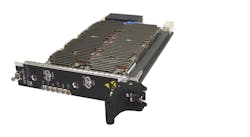Wideband Microwave Transceiver Strives for Versatility
Mercury Systems recently announced that it shipped its first SpectrumSeries RFM3101 wideband microwave transceiver to a supplier of electronic-warfare (EW) systems. This announcement came after the company showcased the RFM3101 at the annual Association of Old Crows (AOC) International Symposium and Convention last November. With this transceiver innovation, the company further leverages its proficiency across a wide range of engineering disciplines. The product is the end result of a collaboration of teams from several Mercury locations.
Supplied in a 3U form factor, the RFM3101 is a 6- to 18-GHz transceiver with an intermediate-frequency bandwidth (IFBW) that spans 1.375 to 2.375 GHz (see figure). Open-systems compliance is a major aspect of the RFM3101, as the transceiver is compliant with the OpenVPX specification. In addition, the RF modules housed inside are OpenRFM-compliant. While EW applications are expected to be a prime area of use for the RFM3101, the transceiver can also enable other applications, such as spectrum monitoring and beamforming.
The RFM3101 wideband transceiver maintains an RF frequency range of 6 to 18 GHz.
“The RFM3101 is a 3U OpenVPX module,” says Brian Kimball, senior product manager at Mercury Systems. “In order to maximize system flexibility, the transceiver includes two interfaces for OpenRFM modules—we call them ‘slim slices’ or ‘bricks.’ In its standard configuration, one module is a receiver and one is a transmitter. Additionally, we can easily mix and match the modules to support other applications. For example, we also have a dual-receiver version that consists of two down-conversion modules. The beauty of OpenRFM is that you can utilize both 3U and 6U sizes. With 6U, you can actually fit five slim slices as opposed to two with 3U OpenVPX.”
In terms of the RFM3101’s functionality, Kimball adds, “There are phase-locked loops (PLLs) onboard. It’s also possible for local oscillators (LOs) to go in and out of the bricks. So, you could have a DDS-based synthesizer or some fast-tuned capability in which you daisy-chain these LOs across modules for coherent tuning and exciting. You can also daisy-chain references—the bricks have reference inputs and outputs so that you can use the onboard PLLs to generate the LOs.”
Both the upconverter and downconverter RF modules deliver 20 dB of gain. They can be set to an attenuation level as high as 31 dB in 0.5-dB step sizes. In addition, the downconverter achieves an output 1-dB compression (P1dB) of +15 dBm at the maximum gain setting, while the upconverter attains a P1dB of +21 dBm with maximum gain.


